To run the forums, host the website, and travel, I charge a universal service fee for my reviews. This review was sponsored by Yamaha. My goal is to be transparent and unbiased, this video and written review are not meant to be an endorsement of Yamaha products.
A sleek purist take on the commuter ebike from a company that is looking to use their household name and reputation to shape the ebike world at large. Today I am excited to finally review the Yamaha Cross Connect. Currently, Yamaha offers 4 ebikes, the race inspired Urban Rush, the mountain YDX Torc, the affordable Cross Core, and the commuter oriented Cross Connect. The Core and Connect dont just share the same Cross name, but they are essentially the same bike frame with the Connect having more options attached to make for friendly everyday use. Years before entering the scene, Yamaha did focused research on the North American ebike market looking at needs and wants as well as pulling data from their use in brand name bikes like Haibike, Giant, etc. If I could summarize the results, I would say they are going for a balance of price, performance, efficiency, and a purist feel. Sounds like a winning combination, so lets see if it lives up to the Yamaha reputation. While only having 1 frame style option, the bike comes in 2 colors: Polar White with Crimson accents or Storm Gray. It comes in 3 sizes, Small, Medium, and Large. For those looking to really dial in the right fit, I recommend checking out the sizing chart on Yamaha’s website as it really gets into detail on each and every measurement on the bike. The frames are a bit on the smaller size, so stem risers are a common aftermarket accessory. Its a lightweight bike overall, I weighed the small and came up with 49lbs. Being a commuter bike, the first thing you will likely notice is the fenders, rear rack, and integrated headlights. The included fenders are plastic and they are full length. The rear rack is sleek and integrated, rated for 25kg (55lbs) which is decent max load given the lightness of the bike. Looking at the integrated rear light, we notice it is plastic with 2 LEDs and is a decent position for visibility, but does leave it a little vulnerable as it sits sticking out of the end. The headlight is a nice aluminum alloy housed unit with internally routed wires, giving it a clean minimalist look. Working our way to the front of the bike, you see this nice SR SUNTOUR NCX pneumatic air fork. Its a lighter fork with a compression clicker which you can set so it doesn’t have to be full lock out. Adjustability like this means you can create some sort of cushion relative to the ground you’re on. I like adjust air pressure just for my weight and set up the clicks depending on the terrain I’m in. The head tube of the fork is tapered, so you could even add your own fork if you have a special one. For tires, Yamaha equipped these 28” CST E-Series Pro’s, which are ebike specific tires rated for the higher speeds. They have reflective sidewall stripes and protection level 6 puncture protection with decent air volume (although narrower). Being somewhat larger tires, they still provide for a lower attack angle which does well to soak up the area if it gets a little bumpy. Complimenting the tires are these nice lightweight rims made of double walled aluminum alloy. There are 32 14 gauge spoke rims with eyelets which is great because that means less of a possibility that they will crack. A quick release axle is present on both the front and the rear wheel, with the front being 15mm and the rear 12mm. Other features include ergonomic locking grips, active saddle, bottle cage bosses, integrated bell, kickstand positioned out of the way for reducing pedal lock, and a 30.9mm rigid seat post. The real big win on the bike his how the PW-SE interacts with the hydraulic brakes and the front and rear derailleurs for a smooth and efficient purist experience so lets dig into that some more.
Driving this e-bike is the compact, quiet, and reliable Yamaha PW SE mid-motor. All of the dealers that I’ve asked about this motor have said that it never comes back with warranty issues… And, that’s not surprising considering that Yamaha comes from the power sports industry and has been making internal combustion engines for decades. They make generators, motorcycles, snowmobiles, jet skis, and a whole host of other machines that get exposed to long term use in rigorous environments. The PW SE is their mid-level electric bike motor, and offers up to 70 Newton meters of torque. It has sensors to measure rear wheel speed, cadence, and torque. It is quite noticeable, yet very smooth at the same time. Its fluid and quiet at low pedal speeds, unlike other bikes that kind of jerk you along a bit. The power rating is 250 to ~500 watts, and the only drawback compared to higher specced PW-X drive systems is that it offers a more limited 110 RPM cadence support as opposed to 120. In short, you cannot pedal faster than 110 RPM and expect much motor assistance, it just doesn’t spin that quickly. For an urban cross bike like the Cross Connect, that’s not much of an issue. There’s a plastic shell built along the base of the bottom bracket to protect the motor from rock and log strikes if you do go off road. And, the motor and battery blend into the seat tube and downtube nicely, the ground clearance is pretty good and everything feels solid and secure. I like how most of the shifter, brake, and power cables are internally routed through the frame of this bike. You can pedal with the motor turned off, and it feels very efficient because there’s no drag from reduction gearing or magnets, but there isn’t a shift sensor here. If you don’t ease back a bit before changing gears, the motor could still be active and stress the chain, sprockets, and derailleur. The Yamaha PW SE motor takes a moment to spin down, but is otherwise very fluid and natural. They advertise a “zero cadence” start feature which aims to reduce knee and hip pressure down, you don’t have to push very hard or for very long before the motor kicks in. For mechanicals, we have two 9 speed Shimano Sora derailleurs one for each the front and the rear making a total of 18 gearing combinations on top of the motor assists levels. The rear is a 11-30 tooth while the front is a 34-46 tooth chainring. A bit of a curious set up, having two chainrings next to each other means they can kind of act as a guide, but still the absence of a legitimate chain cover means you can still catch your pants when riding, so make sure to use a Velcro strap or something. Additionally, have the two means added weight and you could be looking at more tuneups or maintenance. Hydraulic brakes are great and at first I was a little hesitant to get excited when I saw they are 160mm instead of 180mm, but both my test ride and experience from bike shops owners have told us that 160mm does indeed get the job done. Also, having a slightly smaller rotor means it may be easier to park at a crowded bike rack. Overall, this is a Class 1 ebike with a top speed of 20mph, so I think its a really great choice.
Powering this ebike is a 6.6lbs, 36v 13.6ah 489.6 watt hour Lithium-ion battery pack. It’s externally mounted to the downtube, flatter and longer than many competing products, and it tips in from the left side of the frame vs. going in vertically. There’s a lot to like about the Yamaha battery packs… the casing for the 400 and 500 watt hour packs is the same, so it’s backwards compatible if you own a second e-bike with the smaller pack. Maybe you get the Urban Rush model and Cross Connect and then share packs between friends or family? The pack is removable with lock and these unique neat looking little keys. There’s a sturdy, and wide, plastic loop at the top of these packs for secure mounting and transport. There’s even a sealed LED battery indicator built into the battery casing, so you can estimate how full it is without mounting to the bike or turning the bike on. And, the locking cylinder design seems sturdy. I like how it’s positioned up high on the mounting interface to reduce debris and dust exposure while riding. As it is currently designed, the charging interface is positioned low on the left, directly in the path of the left crank arm. This creates a point of vulnerability because the charging plug design is relatively thin and seemingly delicate, made of narrow hard plastic. Compared to Bosch, which uses a wider rubberized plug, I’m always concerned about stepping on the tip of the Yamaha charger tip and I definitely do not appreciate how long, bulky, and heavy the charger itself is… weighing in at 2.3lbs compared to Bosch at 1.6lbs. The fast four-amp output is much appreciated given the 500 watt hour battery, but this charger is one of the bulkiest on the market at this time and I haven’t seen a portable option from Yamaha yet, as I have from Bosch and Brose with some Haibike and Specialized models. In conclusion, this battery pack is great in many ways but definitely has some room for improvement, mostly with the bulky charger. It’s best to store any Lithium-ion battery in a cool, dry location, and avoid dropping and discharging below 20% to maximize stability and lifespan.
In my opinion, Yamaha has been a leader in display and control pad design for electric bicycles since their products began showing up in North America around 2016. Two particular older models come to mind: a large removable LCD unit with remote button pad that was easy to read but somewhat vulnerable to impact (this is what some of the Yamaha powered ebikes used to use). That display was mounted high atop the handlebar, near the center of the stem. And, there’s also a more compact fixed LED unit with limited readouts and integrated buttons (mounted atop the handlebar, near the left grip on some Haibike models). The LED control pad was usually included on value-priced models because it didn’t include as many sub-menus and didn’t offer Micro-USB charging as we see here. For the new PW-X powered electric bikes, Yamaha has drawn on both of these early control interface designs to create a durable but feature rich offering that maintains the Micro-USB port. I love that they kept this interface because it can be useful if you use a smartphone for GPS navigation, Strava, or music, as well as diagnostics and software updates. The PW-X user interface consists of a compact LCD screen, positionable on either side of the stem, and a remote button pad, usually attached near the left grip. This button pad was still very reachable for me during the test rides and would probably remain functional if a second set of triggers was added to control a front derailleur as is the case with the Haibike XDURO AllMtn 8.0. Buttons include a rubberized power button and light button on the display console along with plastic select, up, down, and walk mode buttons on the control pad. Once the display is turned on, the most basic interactions are to arrow up and down through Off, +ECO, ECO, STD, HIGH, and EXPW. Select allows you to navigate through different sub menus including odometer, trip meter, average speed, maximum speed, distance (range estimator), pedal cadence, time, and battery percentage. It was neat being able to test my pedal cadence on the fly, I really appreciate the range estimate to help gauge when to switch down assist levels in order to make it home without running out of power, and the 10-bar battery infographic and battery percentage drive this point even further. You can enable Bluetooth, disable the USB port, and even remove menus from that long list by holding the select button to get into a settings menu. And, there’s one final treat with this display. In addition to the blue-backlit LCD screen, there’s a colored light strip that matches up to the different assist levels. I think the idea here is to make it easy to glance down and know what level of assistance is enabled. It’s a great concept because the LCD itself is on the small side… but in practice, I found the LED readout to be difficult to make out in bright daylight. At night and in the woods it probably works great, and might even be distracting. And so, it’s also nice that you can completely disable the LED light strip back in the settings menu. All in all, this display does an excellent job. It mostly stays out of the way and is easy to interact with while pedaling, even without looking down because of the sloped clicky control pad design. It is not removable and cannot be swiveled to reduce glare, but the large plastic bezel looks tough and seems well protected inline with the stem. I love how clean and open the handlebar is, allowing plenty of room to attach a phone or light, the position of the display it self stays pretty protected by the stem and handlebars. Note that there is light button to activate the integrated lights as well. Overall, it is a bit of a busy cockpit with 3 finger brake levers, trigger shifters on the left and right for both derailleurs, and the display and controls.
In conclusion, I am really glad I got to get in-depth with the Cross Core. I really do think that Yamaha is on track to balance price, performance, efficiency, and a purist feel. Although Yamaha is a big name and really did their homework, there are still a couple of tradeoffs to consider if you want this to be a perfect fit for you. At this point, it may feel like nitpicking, but some of these concerns may be valid to you, so its worth mentioning. The plastic housing for the LED lights in the rear are in a precarious spot; some dealers have told me they have experienced broken lights out of the box because of the positioning getting bumped around. Additionally, please be careful when lifting the bike from the rack and take certain loading precautions. Also, the pedals are a little generic, somewhat narrow, and plastic. A small point to make, but this was likely to keep cost down and pass those savings on to consumers. I do worry about the maintenance that could come up with two derailleurs and I wish we saw some new extras like shift detection or a smaller, more portable charger, but these are all things that probably won’t hinder you enjoyment of the Cross Connect itself. As a matter of fact, there is just so much smoothness, efficiency, and cleanliness (love the beautiful internal cable routing) that it will likely be a standard bearer for a long time as to how to get everything in harmony. Its no small wonder as to why they use a tuning fork for their logo… this bike strikes fantastic balance for commuters. It has a considerate 3 year warranty backed by a 65 member and growing dealer network. The dealers get reimbursed for work done too, so any of them should be happy to help you with any needs should they arise. Considering the MSRP is $2,999, it seems like a fair price on par with the theme of balance.
As always, I welcome questions and feedback in the comment section below. Whether you own the bike, have taken a test ride, or are brand new to the space, my goal is to provide an objective and honest resource. You can also join the Yamaha Ebike forums and share your own photos, videos, and review updates to help others! Have fun out there, and ride safe :)
Pros:
- Quiet efficient mid-drive PW-SE motor, proven and reliable tech with a great natural feel and protected display
- Has an integrated rear rack with 25kg max load (55lbs), as well as integrated front and rear lights, and full fenders
- Comes in 2 colors, Polar White with Crimson accents or Storm Gray, also comes in 3 sizes, Small, Medium, and Large
- SR SUNTOUR NCX pneumatic air fork, its a lighter fork with a compression clicker which you can set so it doesn’t have to be full lock out
- Has a nice set of 28” CST E-Series Pro’s, which are ebike specific tires rated for the higher speeds, including reflective sidewall stripes, and protection level 6 puncture
- Some nice lightweight rims made of double walled aluminum alloy, 32 14 gauge spoke rims with eyelets which is great because that means less of a possibility that they will crack, a quick release axle for both the front and the rear wheel, with the front being 15mm and the rear 12mm
- Integrated bell and kickstand, with the kickstand being positioned out of the way to avoid pedal lock when backing the bike up
- The PW SE is capable of measuring rear wheel speed, cadence, and torque, it is rated at 60nm and 250-500w of power with 110rpm cadence support
- The drivetrain and powertrain play well together, there are two 9 speed Shimano Sora derailleurs (one for each the front and the rear) making a total of 18 gearing combinations on top of the motor assists levels
- 160mm Shimano hydraulic brakes come standard with 3 finger levers, adequate stopping power for this lightweight setup
- 36v 13.6ah Yamaha battery with a 4amp charger, making for a little quicker than the 2amp chargers we sometimes see
- The PW-X display is positioned wonderfully by the stem and handlebars, keeping the already rugged aesthetic even more protected in case of a crash or debis
- Most companies do a 1 or 2 year warranty, its nice to see a big name like Yamaha get competitive and offer a 3 year warranty, really standing behind the product
- A great balance of price, performance, efficiency, and a purist feel
Cons:
- The pedals are a bit narrow, plastic, and somewhat generic, likely chosen to keep costs down
- Its nice the fenders are full length and included, but it should be noted those are plastic as well
- The plastic housing for the LED lights in the rear are in a vulnerable spot; some dealers have told me they have experienced broken lights out of the box because of the positioning getting bumped around, could also be an issue when lifting from the rack or loading
- Two derailleurs mean added weight and could be more maintenance and tuneups, similarly, there is no chain cover (although the second ring can act as a chain guide), so be careful with pants
- No shift detection, so ease off a bit when shifting gears to get the full smooth effect
- Yamaha’s standard battery charger is nice and quick because is is 4amps, but it is on the bulky side and has fixed long wires, making portability somewhat of an issue
- The frame integrated wiring is beautiful, however, you do see more ebikes getting battery and mounts integrated into the frame as well, it would have been nice to see that from Yamaha, considering they are seen as a premium brand
Resources:
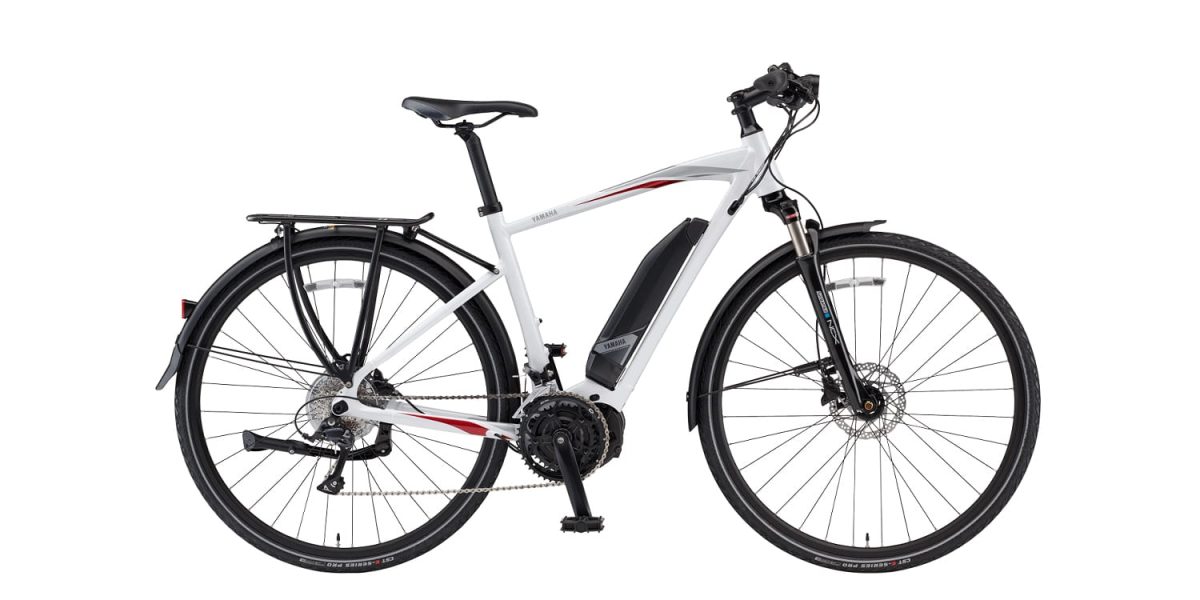















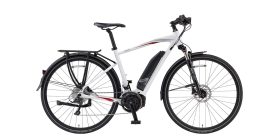
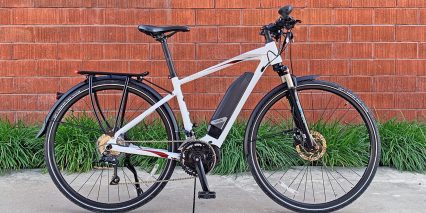
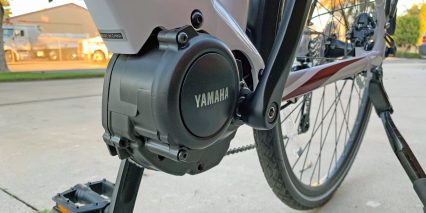
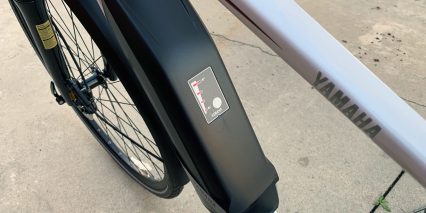
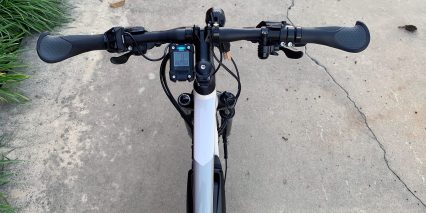
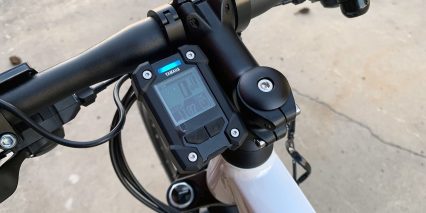
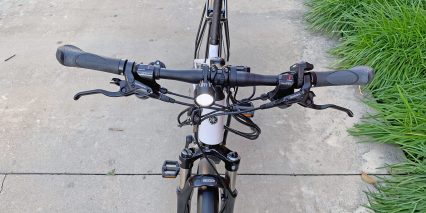
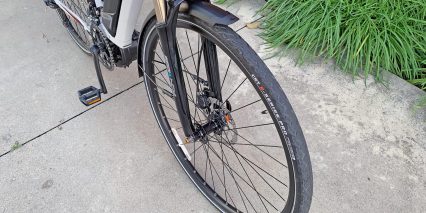
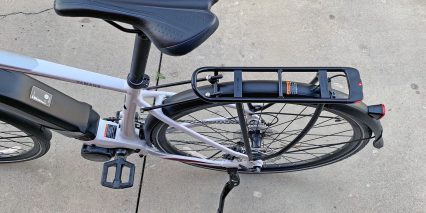
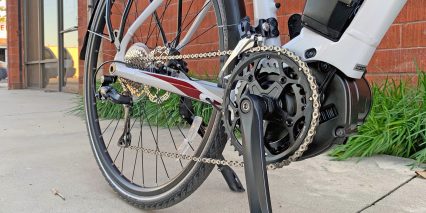
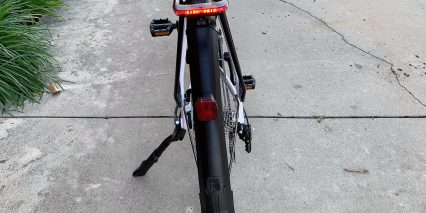
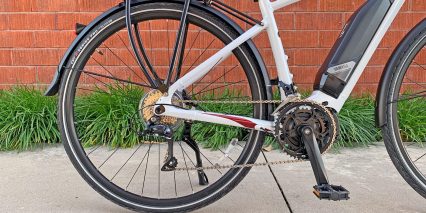
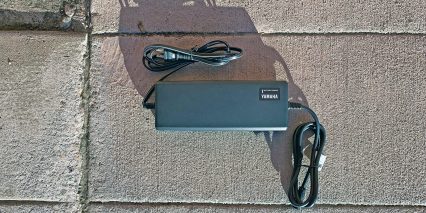
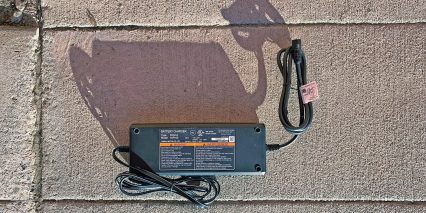
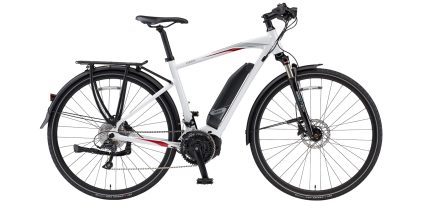
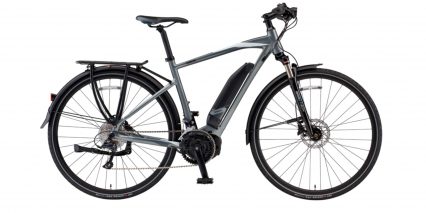

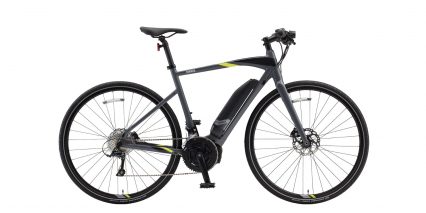
Mike
6 years agoThere is considerable value and quality built into this E-bike, and I am not sure that has been adequately articulated in your review. I had to read your review 3 times, before getting a feel for what you were attempting to say. Maybe it was the long paragraphs, or many isolated or unrelated things crammed together, or not a good writing flow? Important things seemed to get buried or not appropriate attribution. Not sure, but this review was a not an easy read vs many others that have been done here.
In any event, here are some points to add which may add a little bit more to what Yamaha has designed and built here for every rider: (in no particular order)
In any event, while you had a long and wordy review, overall it came across as somewhat bland, unenthusiastic (especially when compared to many other of your reviews), which made many of the positives you did mention, feel buried and not remarkable, again especially for all that someone is getting at this price point. Mid drive ebikes are not known to be inexpensive, so getting Yamaha’s quality reputation here, with an $11 billion company standing behind it for 3 years under warranty on the most important items, totally makes this ebike a serious contender for anyone thinking of being able to spend between $2500 and $5000 for some other brands from much smaller and less tenured companies. (the CrossCore which I imagine you have reviewed, but not published, starts at $2399. Not bad, and not all the features of this one, but very solid, high quality, nice riding, ebike for anyone. And not just for ‘purists’. (whatever that means.)
ReplyDavid Miller
6 years agoThank you for a very helpful and informative review! Question- I ride a 60 frame. It Iooks like the largest Yamaha frame is 50. Any idea about howI could make this bike work for me.
ReplyMike
6 years agoDavid – not knowing your height, in-seam, or reach, it would be hard to make any responsible recommendation, however usually the best place to start is with a professional fitting.
Yamaha’s sizing chart shows that people up to about 6′ 5″ could fit on this Large version of the CrossConnect. I would not just go by a ‘frame size’, as Yamaha has done a careful job of designing an appropriate stack and reach, and while people do suggest their frame’s seem smaller than normal, a professional fitting might in fact demonstrate that the frame would work for you well, (and what adjustments might be needed) and depending what posture you want to maintain, and taking into account what riding conditions you will be experiencing most frequently.
Drew Englemann at Yamaha is very experienced at this, and so depending where you reside, he might be able to recommend someone locally who can perform a professional fitting for you. I’ve sent him a private note on your behalf, and perhaps he will respond, and one of us can get back to you. Feel free to PM me too, and I can forward to you his email, or send his response.
Paul Kane
6 years agoMike, you just sold me an ebike! If you don’t work for Yamaha, they should hire you as a pitchman! I’ve been racking my brain for a month researching every single bit of information I could find on theses bikes. I love most everything about the CrossConnect but am afraid to pull the trigger because I don’t have a single dealer in the state of Virginia that sells these. I would have to drive 4 hours to Raleigh North Carolina just to test fitting and ride. I understand these bike run extremely small, I saw the video with Court and Sam. Sam is 6′ 3″ and he looks awfully cramped on the large frame. I would prefer the Crosscore but am worried about the rigid front fork. I’m used to carbon and have had 3 wrist surgeries and a bad neck. I need my handle bars to be every so slightly higher than my saddle to be comfortable. I also would prefer a wider tire but have never ridden a bike with a front suspension and am hopeful that adding some type of seatpost suspension would do the trick.
At age 59 I’ve been battling a chronic lymphocytic leukemia diagnosis and get tired easily and am hoping this Ebike will allow me to continue riding for many more years. I just got a hitch installed on my car today and looking to get an ebike friendly rack tomorrow. I wish there was a dealer that had Yamaha in Virginia. I can’t wait to ride again. – Paul
ReplyCourt
6 years agoHi Paul! I hope the CrossConnect works out great for you, and that you find a good hitch rack. I actually filmed the Thule EasyFold 2 recently and plan on posting an accessory review article soon. It’s a great rack, but fairly expensive… but with your leukemia, it could be the easiest way to get the bike onto your hitch. I sincerely hope that the ebike will allow you to continue riding and enjoying life. Thanks for sharing your enthusiasm, thanks, and optimism with all of us here. Ride on!
Drew Engelmann
6 years agoHi Court! Thanks to you AND Sam for helping out by taking the initiative to do the review while our schedules were not able to line-up. You guys are total pros. Much appreciated.
I’m looking forward to getting the other 3… or 4 (wink, wink) of our bikes under you in the weeks to come. I’ve been wanting to get out for a ride with you to share all of the stuff we’ve been working on for the last few months and learn more from your feedback. Thanks again.
All the best,
ReplyDrew
Yamaha Power Assist Bicycles
Court
6 years agoHey! Thanks for the official comment here, Drew. Great to hear from you… Yeah, I’ve been so excited about your products and had this opportunity to film with Sam and get a dealer perspective. Very much looking forward to filming with you to get the official word and some more technical details in the coming weeks. We also shot the Cross Core that will go up in the coming week or so. You guys did a great job on these ebikes, hope you’re managing with the busy travel schedule :)
ReplyPaul
6 years agoFINALLY! Just took a leap of faith and ordered a gray, large CrossConnect today! I can hardly wait the 2 weeks it will take to get the bike shipped to Maryland! Much thanks to all that helped me make very difficult decision being that I was not even able to find one to test for fit or ride. I just love the way the bike looks and all the great reviews. Thanks again to Rob and Thomas at Electric Cycling House, Steve and Cody from Yamaha, and Court and Sam for their in depth review. Also Mike of course for his awesome comment on this post. Hitch, installed and bike purchased today. Now I just need a ebike hitch rack for under $500 and I’m off!
ReplyCourt
6 years agoAwesome! This is wonderful to hear, thanks for the update Paul :) be sure to drop in once you’ve received and test ridden the bike for a bit. I’d love to hear about the experience and how the bike meets your hopes, or any issues that come up.
ReplyMike
6 years agoMy personal view is that this bike is incredibly good value and is a perfect choice for a 1 e-bike owner to use for commuting and some recreation. My sense is that this is a very sought after niche in the market. Two questions: 1) What in your view are good comparatives for this crossover category? Do you think this crossover type bike warrants a category of its own? Being a fairly early adopter of e-bikes I have a lot of people ask be for advice. Most often they are looking for a versatile and nimble commuter that can handle some occasional tame single-track or gravel to connect roads and paths. One of my 1st questions to them is around their budget and price expectations. Interestingly most haven’t even given that much thought, and have found that my $3K to $3.5K answer is usually met with pleasant surprise.
ReplyCourt
6 years agoHi Mike, I’m not sure if this is exactly what you’re talking about, but I have started a gravel ebike category. I’ve seen more “cyclocross” inspired ebikes as well. There’s a lot of blending happening in the industry as companies try to create products that bridge gaps and provide “everything” all in one. It sounds like you’ve become a great resource for friends who are curious about electric bicycles… indeed, the price tag shock is something I see all the time. I’ve kind of gotten used to it, and created an “affordable” ebike category here on the site, to help guide people who are price sensitive. But all of the name brand stuff seems to be at least $1.5k, and usually above $2k for the really good stuff :)
ReplyDickie T
5 years agoCouple of questions on the CROSS CONNECT…#1 Has anyone fitted wider tires to their CROSS CONNECT? I ride mostly rails-to-trails and prefer 38-42mm tires.
#2 What sort of max range per charge can one expect again riding rails-trails which are typically pretty, flat firmly packed crushed limestone and/or gravel averaging 12-13 mph?
Replymichael c sinclair
4 years agoNo step thru? Forget about it.
ReplyCourt
4 years agoI hear you michael, it’s nice to have a step-thru or even a mid-step “mixte” frame option for approachability. Consider one of the Trek models with comparable specs and more frame style and size options :)
Replymichael c sinclair
4 years agoLike the Trek, but no throttle? Thinking I like a throttle?
ReplyCourt
4 years agoHi Michael, yeah… most of the “big brands” such as Trek, Specialized, Giant, and Yamaha do not offer throttle on demand because it’s a gray area for ebike laws. In Europe, nobody is allowed to offer throttles, so I think they just continue their hardware for the US without adding the feature (smaller markets in North America). This is where brands like Rad Power Bikes, Aventon, RIZE, Magnum, Pedego etc. all have an advantage. I hope this helps, there are very few mid-drive ebikes that do offer throttle due to the demands it puts on the motor and drivetrain, DOST is one of the very few.
ReplyMax
4 years agoThe most frustrating feature of nearly every electric bike/motorbike review is the consistent refusal of reviewers to describe the range. What is with that? Here is a huge, detailed review with some pretty detailed rebuttals, but no one will discuss range. This is a massive, irresponsible failure on the part of reviewers and I can only wonder at the motives. Have they simply not done the research? Are the products just that bad? It is probably the most important piece of information that EVERYONE wants to know and yet it is the most difficult-to-find piece of information.
ReplyCourt
4 years agoHi Max! I do estimate a range for each bike based on battery capacity, but it’s not something I test out because it would take too long and only be relevant to my body weight, my tire inflation level, my chosen ride terrain, my temperature outside, and my battery age. Each of these factors impact the results, and they can vary more than you’d think… like 50% decrease in range on extremely cold days if the battery is also cold. One way to estimate is to take the watt hours offered by the battery pack (like 500 watts for example) and then divide by 20 to get a reasonable minimum estimate. So in this example, I’d estimate 25 miles (or 40 kilometers). This is with the higher level of assist or using a throttle, on paved surface with no wind and a 170lb rider. That’s the industry standard for range estimation… but it only applies well to a hub motor. With a mid-motor powered product that has no throttle, you can expect much more range. Again, I don’t discuss it much on individual reviews because there are so many factors… but I hope this comment reply helps you. I am the one who has reviewed the vast majority of bikes on this website, since 2012. I own this website, and I’ve gathered this feedback from friends, shops, and my own ride experience :)
ReplyDaniel Thaler
4 years agoI am looking at the Cross Connect. The sizing chart indicates that a medium (I’m 5’8″ with a 31″ inseam) would fit me but the local dealer says the sizes run small and a large would be better. I haven’t had the opportunity to sit on one yet. Does anyone have real world experience with this?
ReplyCourt
4 years agoHi Daniel! Sorry for the slow reply, this is Court… the guy who reviewed the bike. Yes, I remember them running small. My own inseam is about 30.5″ and I’m 5’9″ and would go for the large size frame. Hope this helps, the Medium would probably work, but it felt a bit small to me.
ReplyDaniel Thaler
4 years agoThanks for the reply! I went to the local store (Sleek ebikes in Tarrytown, NY) where they had one. I rode it and really liked it. I ordered one and was told it would be two weeks. The next day I get a call. Nope, supply problems, it’ll be October. But, they had a Bulls Sentinel that had been returned virtually unused by the NY State Police that they would sell for the same price as the Yamaha. I rode it, bought it and love it. A beast of a machine.